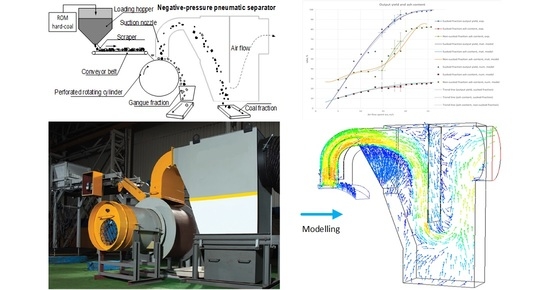Modelling of Hard Coal Beneficiation Process Utilising Negative Pressure Pneumatic Separator
Abstract
:1. Introduction
2. Materials and Methods
2.1. Experimental Setup
- The speed of the conveyor belt (inverter control in the range of 0–50 Hz);
- The speed of the perforated rotary cylinder (inverter control in the range of 0–50 Hz);
- The rotational speed of the fan (inverter control in the range of 20–50 Hz);
- The position of the suction nozzle above the surface of the rotating cylinder (manual control) and;
- The position of the scraper, i.e., its height above the conveyor belt (manual control).
2.2. Materials
| η —enrichment efficiency, % | εa —actual enrichment ash yield, % |
| εw —washability ash yield, % | εn —no enrichment ash yield, % |
2.3. Mathematical Model
| wa —vertical air speed (relative to the grain movement), m/s | wx —horizontal grain speed (relative to the air flow), m/s |
| g —gravitational acceleration, m/s2 | FD —drag force, N |
| Fg —gravity force, N | d —grain diameter, m |
| R —rotary cylinder radius, m | ρa —air density, kg/m3 |
| ρg —grain density, kg/m3 | m —grain mass, kg |
| CD —drag coefficient, - | ω —rotational speed, rad/s |
| A —grain cross-section, m2 | V —grain volume, m3 |
- Related to the physical properties of the material,
- Related to the physical properties of the medium (fluid) in which the separation is carried out and,
- Operating parameters of the device itself.
- A = exp(2.3288 − 6.4581Φ + 2.4486Φ2); B = 0.0964 + 0.5565Φ;
- C = exp(4.905 − 13.8944Φ + 18.4222Φ2 − 10.2599Φ3); D = exp(1.4681 + 12.2584Φ − 20.7322Φ2 + 15.8855Φ3).
- Process parameters (physical properties of grains and fluid, device operating parameters) are constant for a given simulation;
- The air velocity profile in the suction zone is vertical-only and uniform;
- Due to the non-streamlined shape of the grains, the impact of aerodynamic drag due to friction of the fluid against their surface is ignored;
- The coupled effect of grains on the fluid flow is omitted (volume fraction of the particles in the flow was estimated to be about 0.5%);
- Grain rotation or interactions between them (collisions) are not included;
- The initial position of the grain (x, y coordinates) depend on the grain diameter and nozzle position:
- ○
- y0 = above the cylinder’s surface;
- ○
- x0 = position of the nozzle front wall + .
2.4. Numerical Model
- Conservation of mass:
- Conservation of momentum:
| ρ —fluid density, kg/m3 | —stress tensor, kg/m3 s |
| t —time, s | —gravitational body force, m/s2 |
| —flow velocity field, m/s | —external body force, N. |
| p —static pressure, Pa |
- Interaction between the individual grains (collisions) and grain degradation effect due to collisions with the separator were not included;
- The particle trajectory was simulated only until the first contact with the inner walls of the separator (wall-trap condition);
- A perforated cylinder was simulated by a “pressure inlet” boundary condition, permeable to fluid but reflecting DPM (wall-reflect) particles.
2.5. Validation
3. Results
3.1. Pressure Measurements
3.2. Modelling
4. Discussion
5. Conclusions
- Prediction of output yields and physicochemical properties of the fractions for a given material with a known size and density distribution (preferably flakiness index as well) at various operating parameters of the device,
- Optimization of the NPPS operation,
- Analysis of the influence of each device operating parameters on the effects of the separation process (output yields and physicochemical properties of obtained products),
- Analysis of the impact of individual physicochemical properties of the feed materials on the results of the separation process,
- Analysis of the impact of changes in device geometry on the separation process, and thus possibility of optimization of the device design (only numerical model).
Funding
Conflicts of Interest
Appendix A
Appendix A1. Coal no. 2
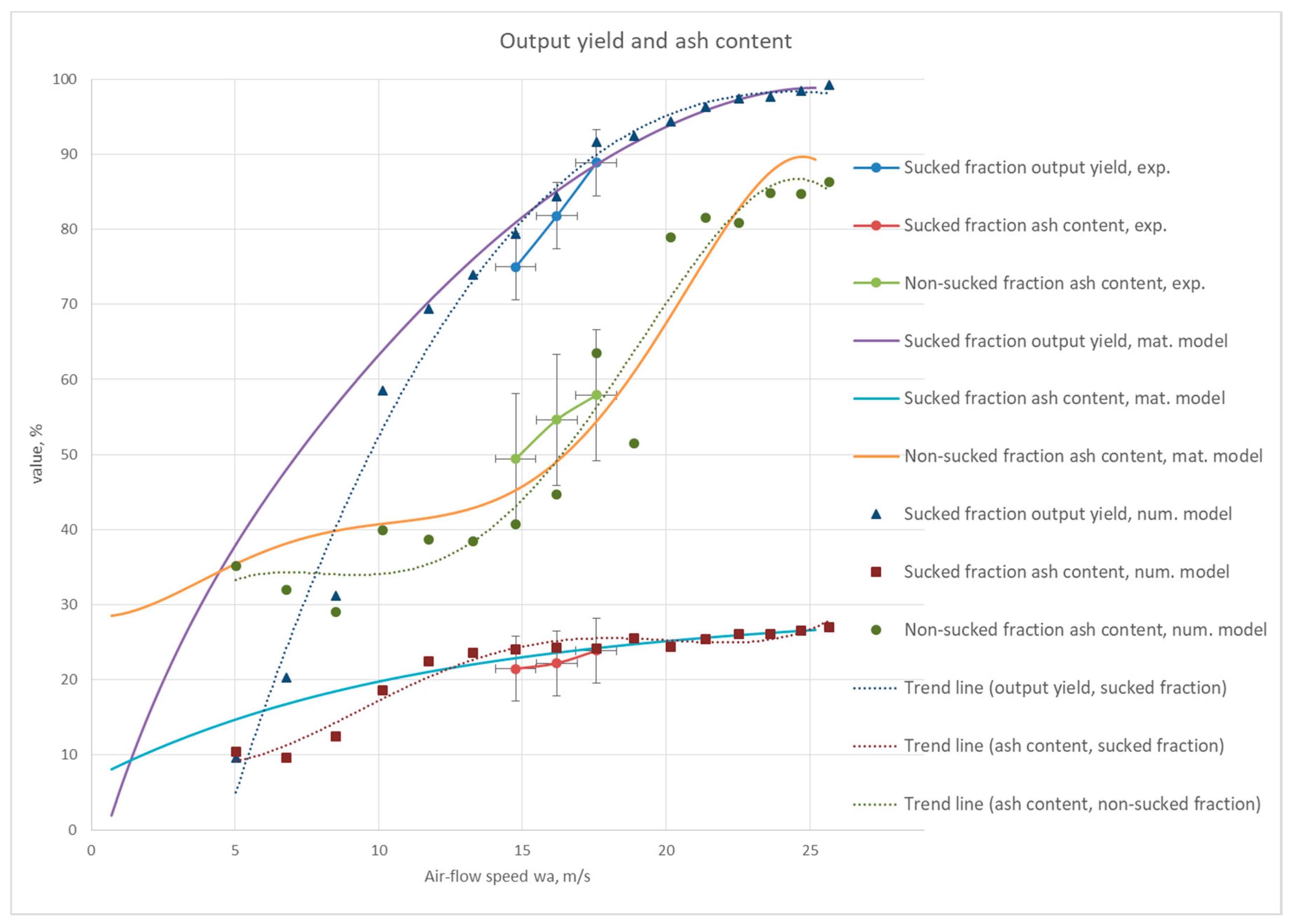
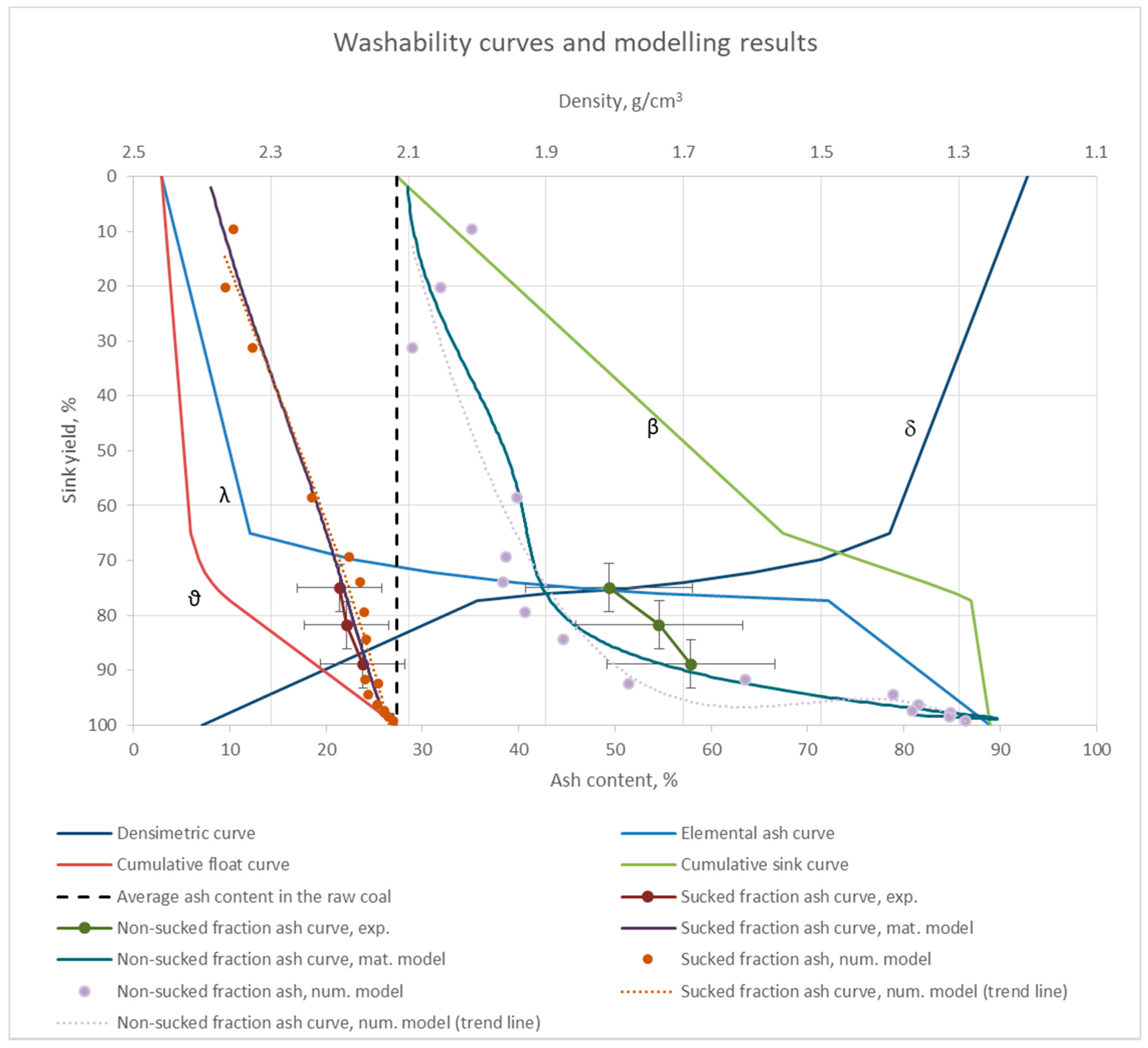

Appendix A2. Coal no. 4
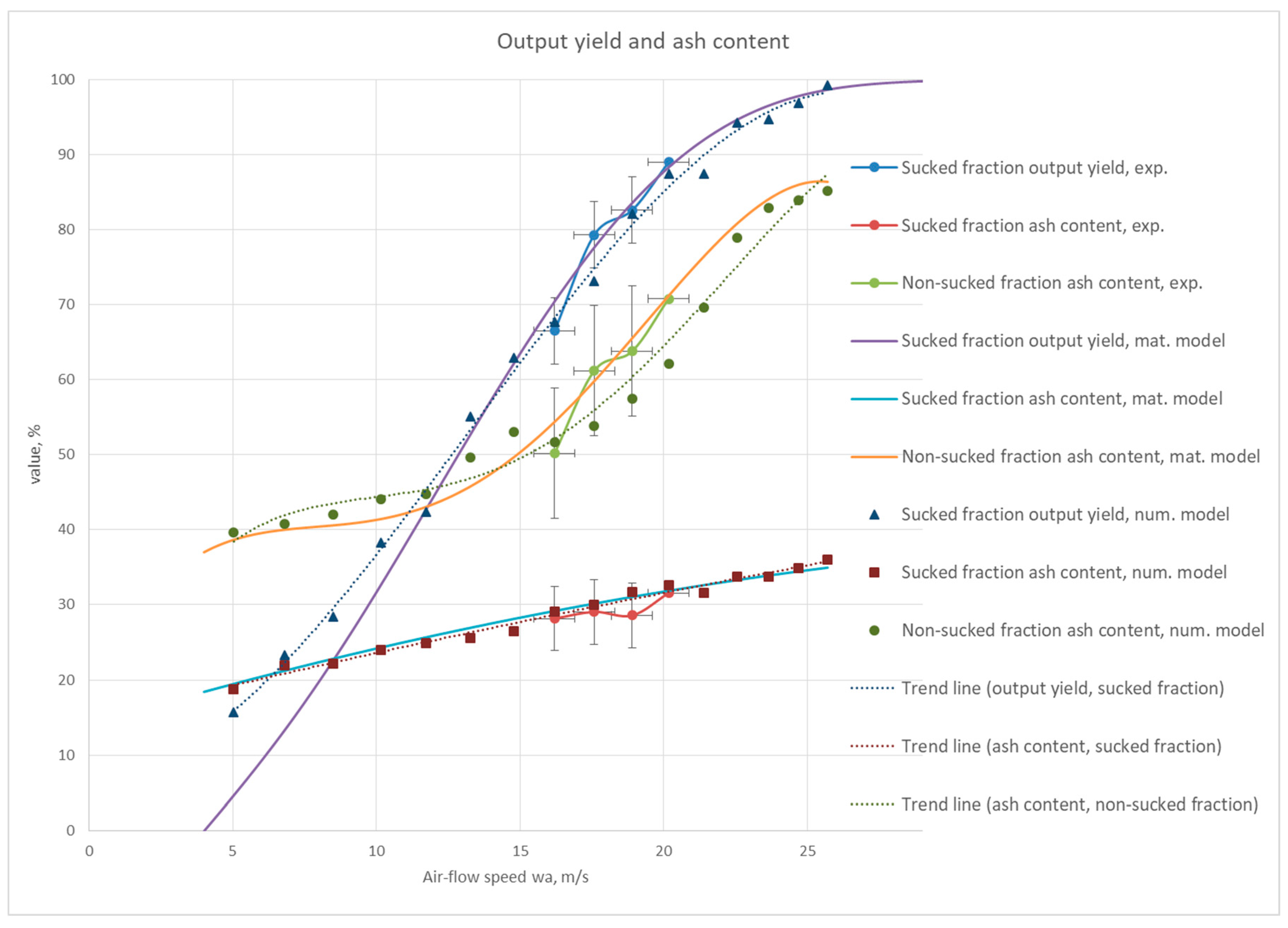
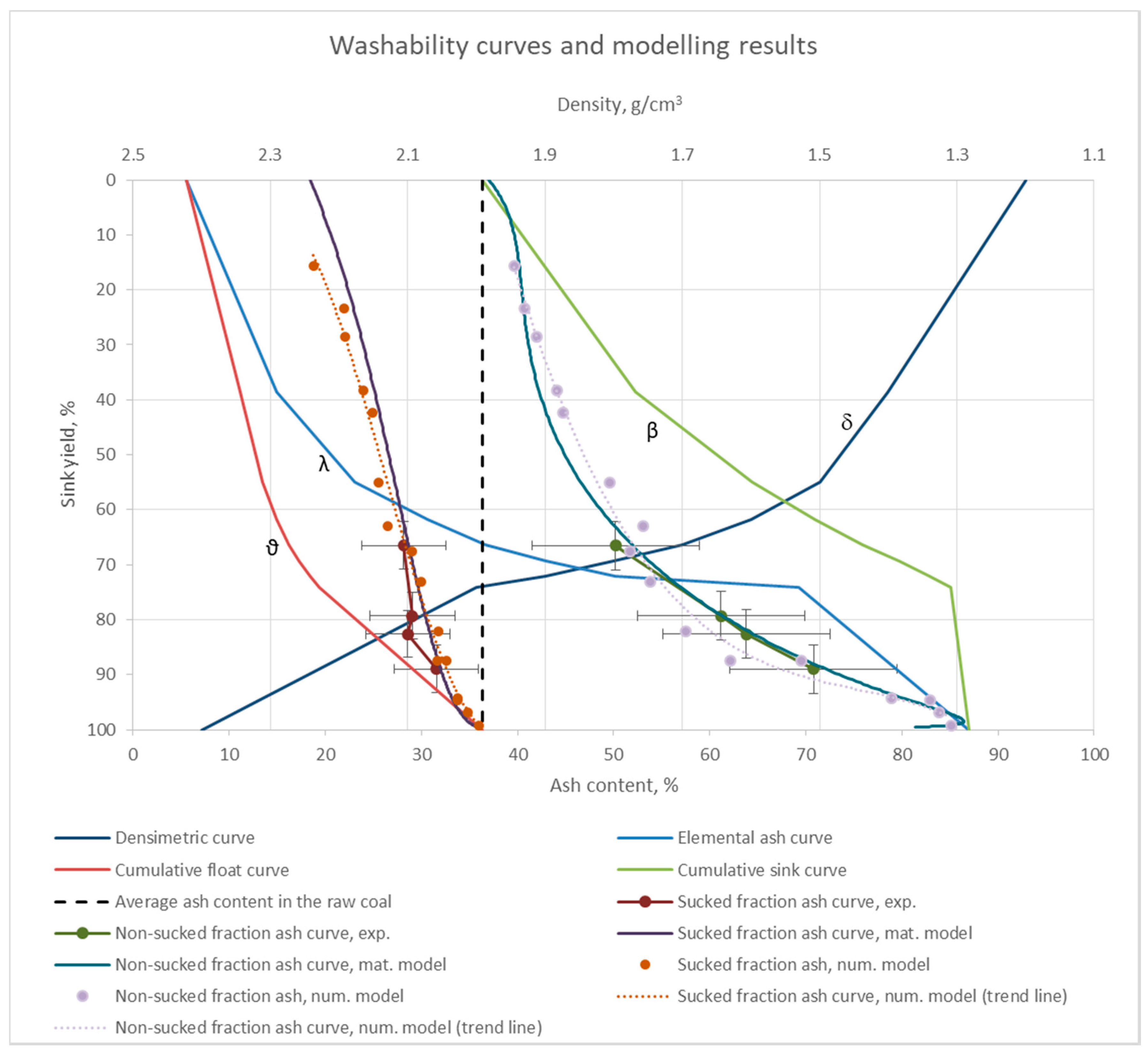

Appendix A3. Coal no. 5
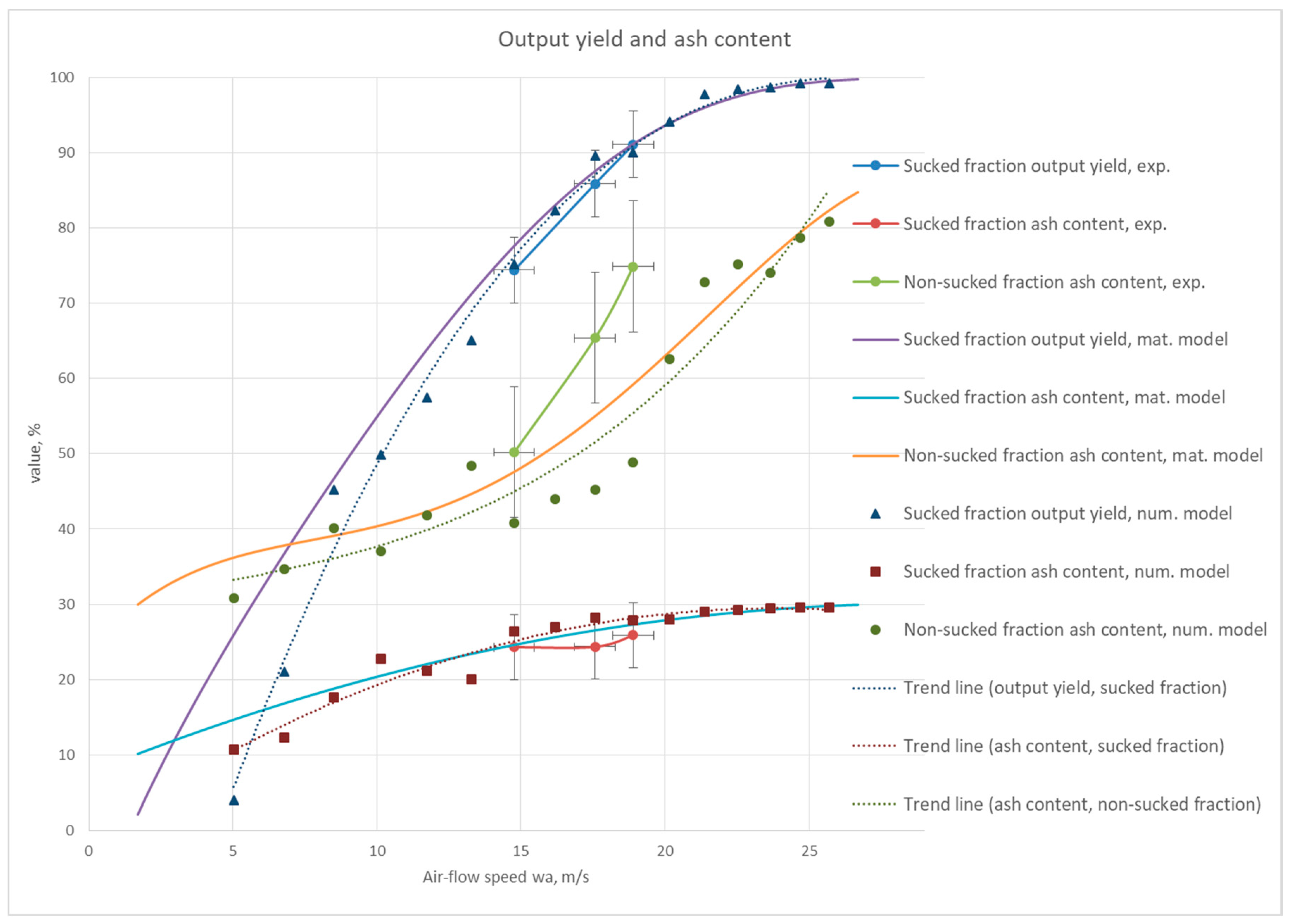
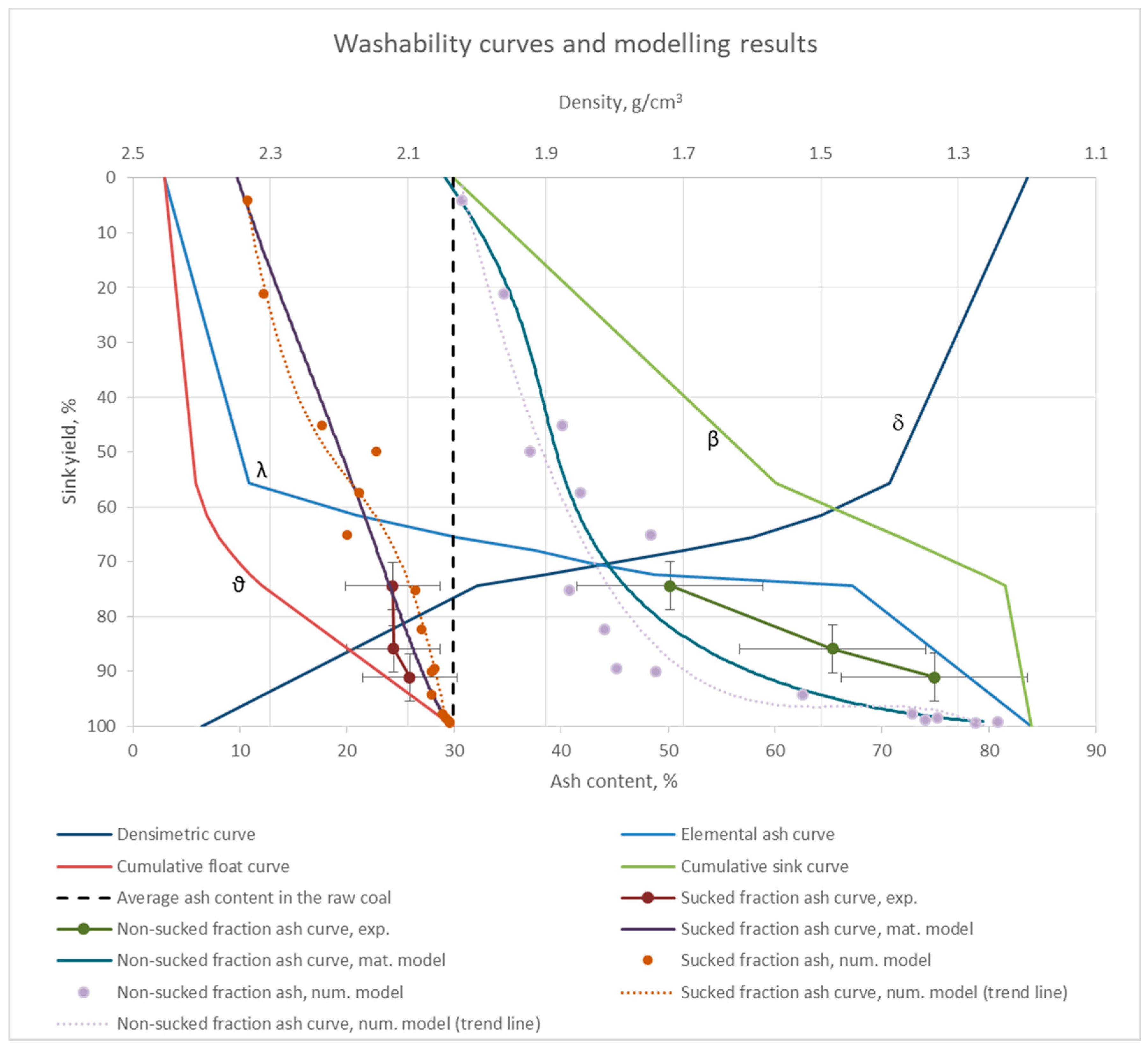

Appendix B
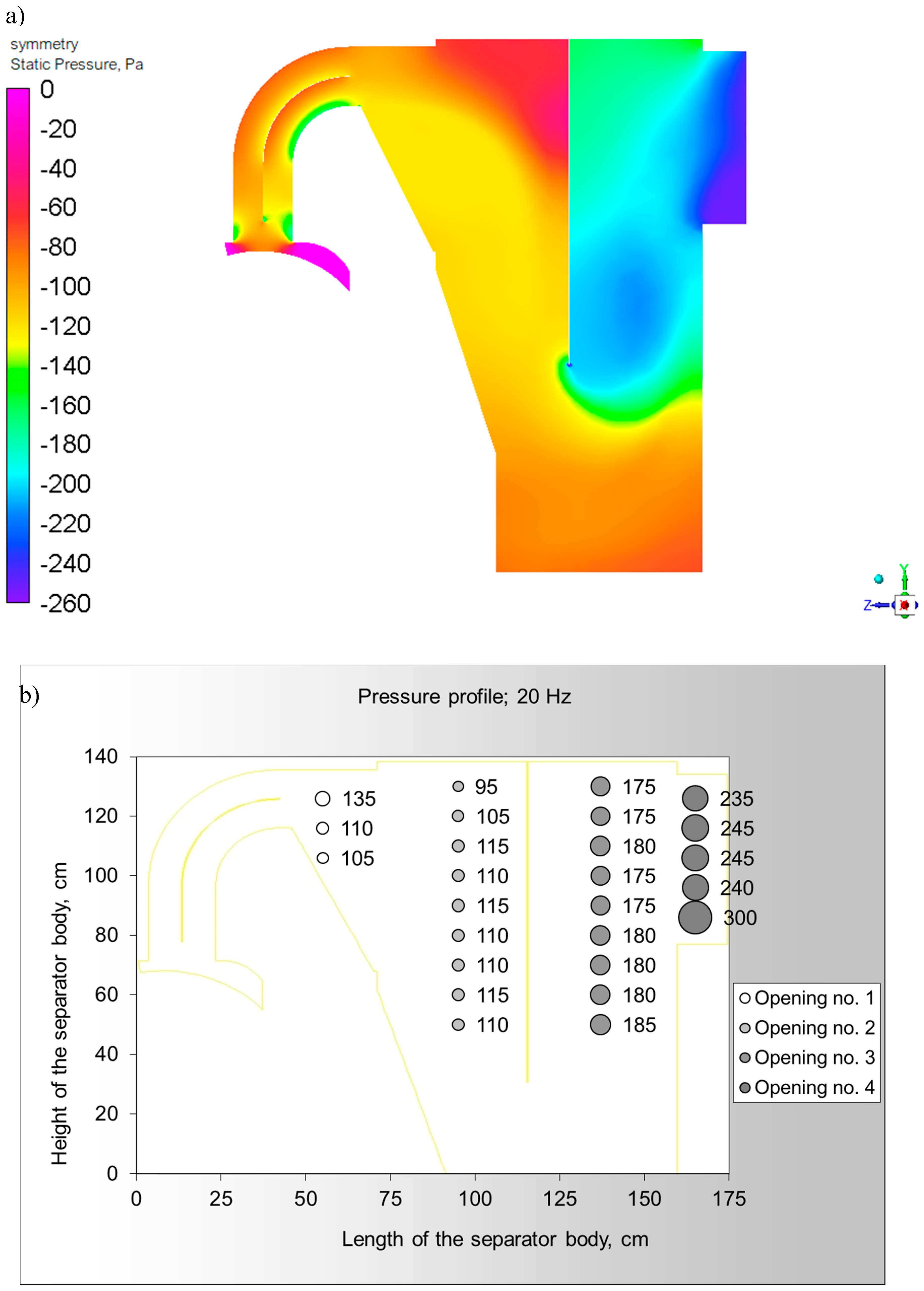
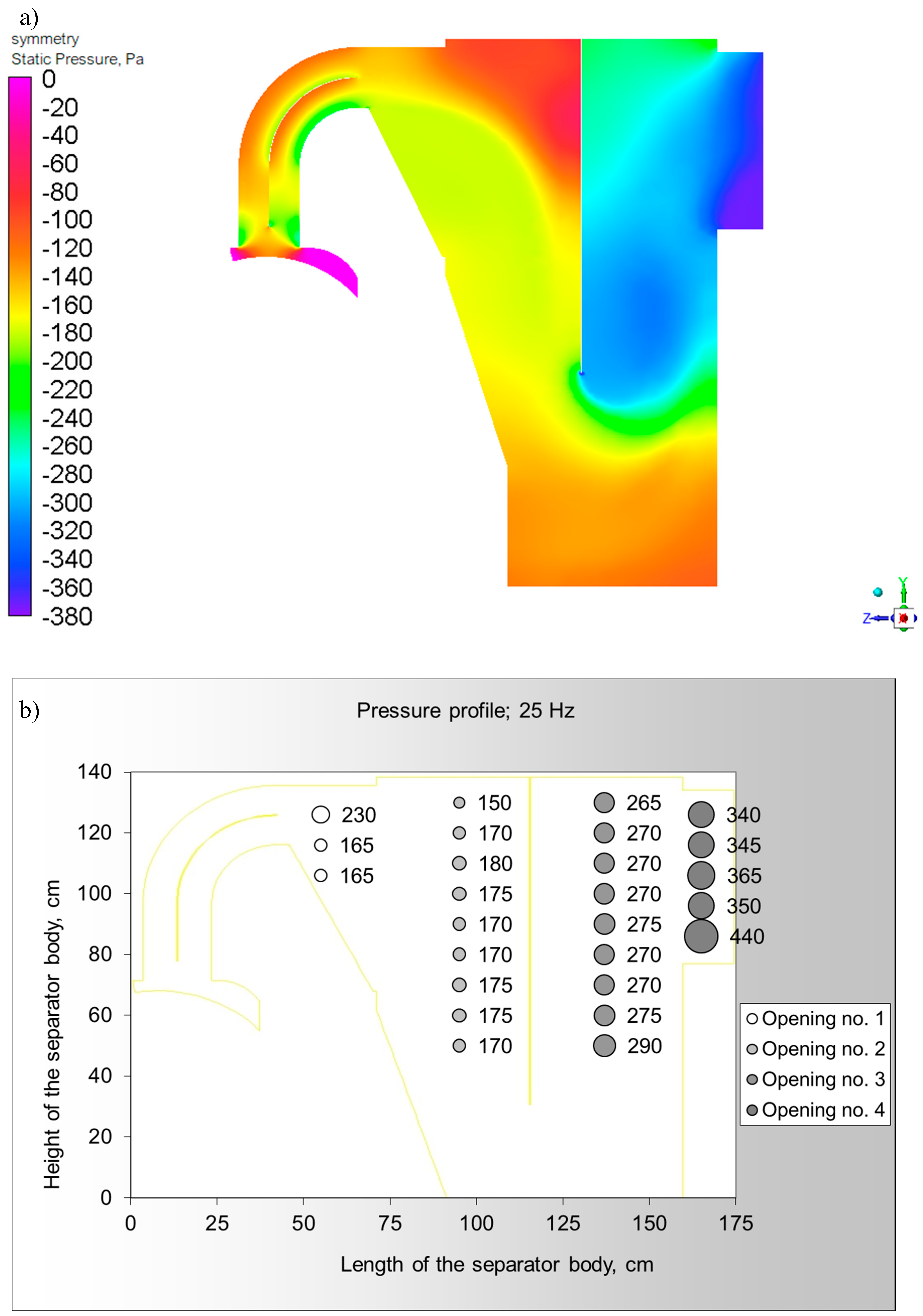

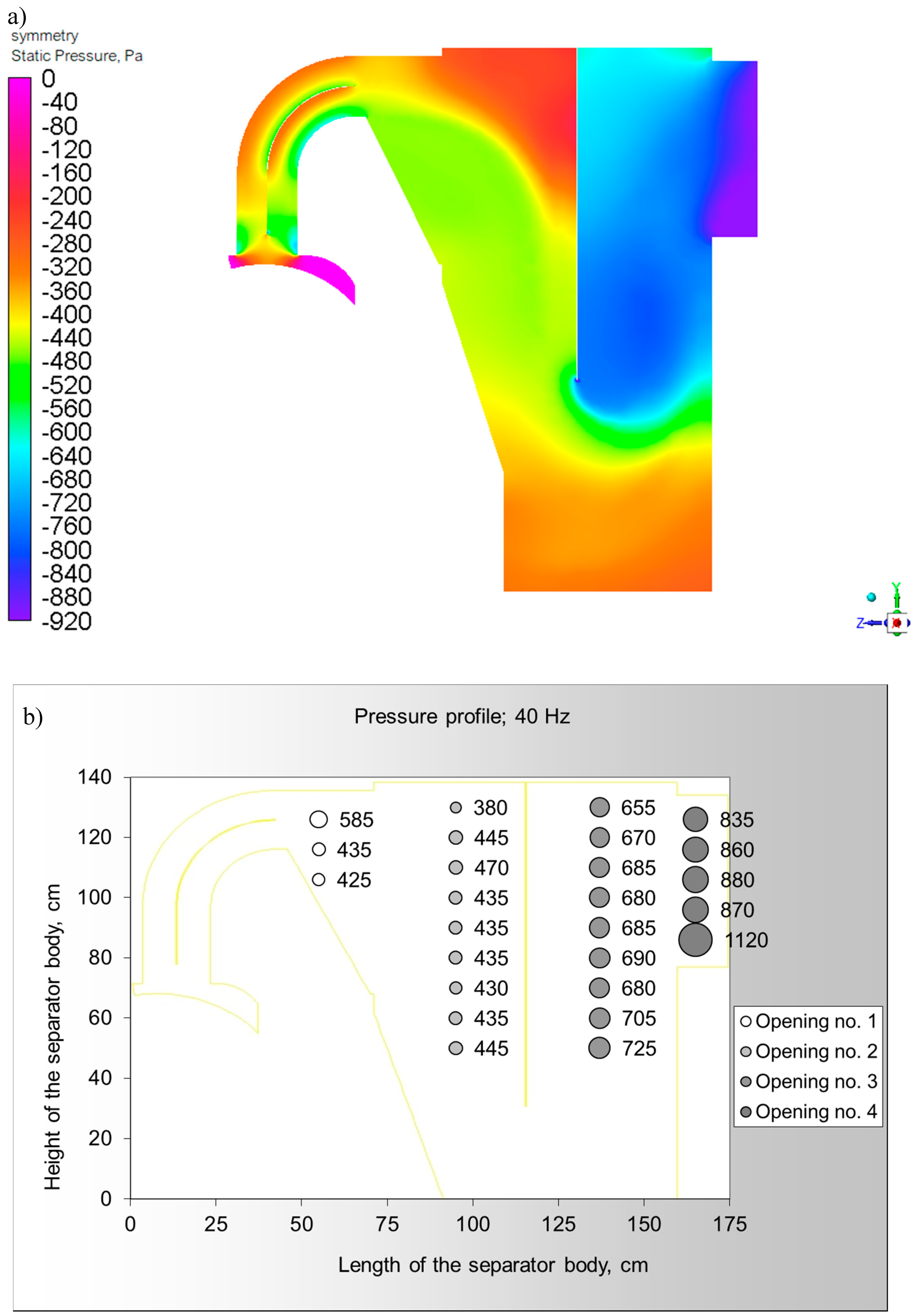

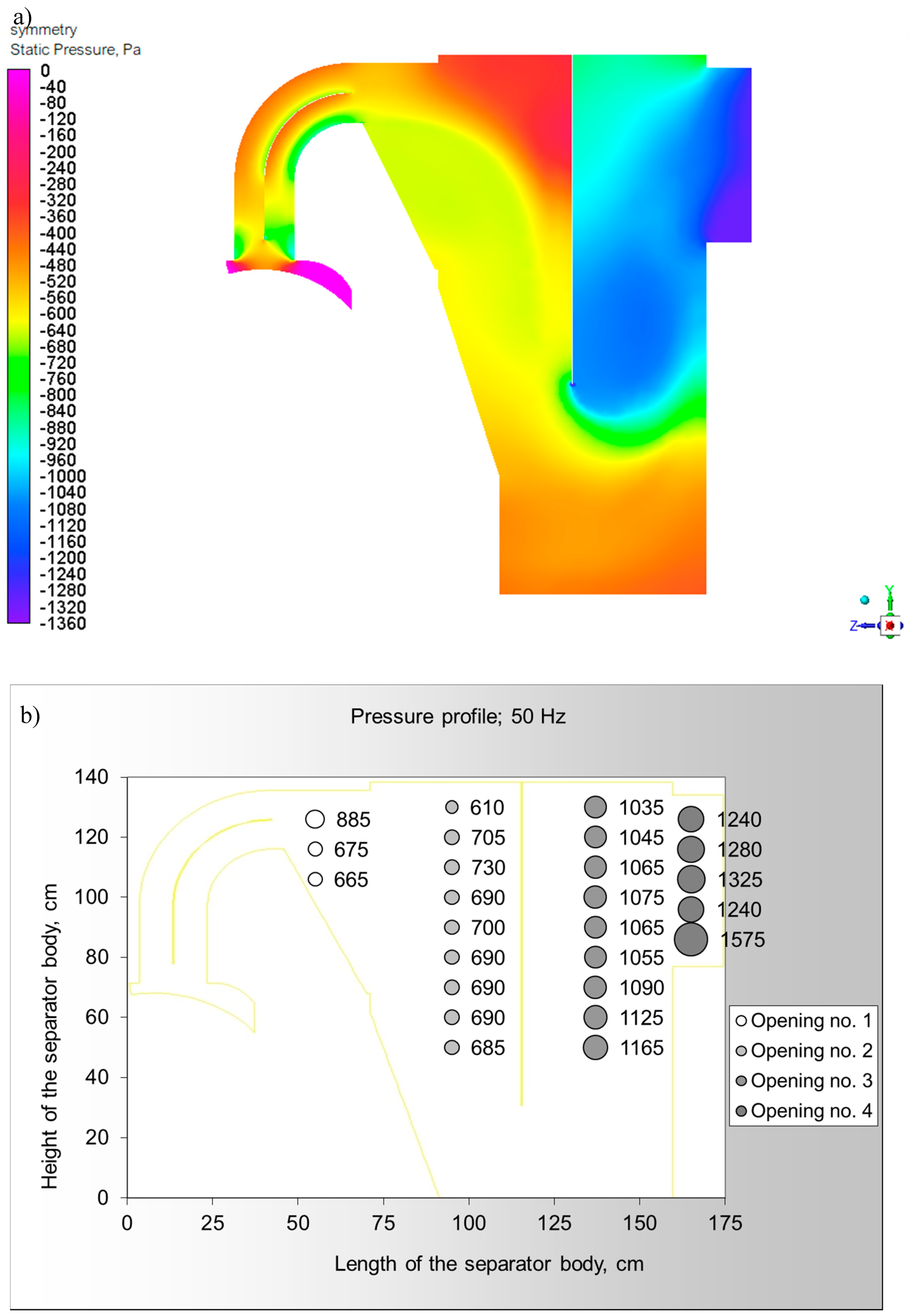
References
- World Energy Council. World Energy Resources: 2013 Survey. Available online: https://www.worldenergy.org/publications/entry/world-energy-resources-2013-survey (accessed on 29 July 2019).
- U.S. Energy Information Administration. International Energy Outlook 2016. Available online: https://www.eia.gov/outlooks/archive/ieo16/ (accessed on 29 July 2019).
- Lockhart, N.C. Dry beneficiation of coal. Powder Technol. 1984, 40, 17–42. [Google Scholar] [CrossRef]
- Van Houwelingen, J.A.; De Jong, T.P.R. Dry cleaning of coal: Review, fundamentals and opportunities. Geol. Belgica 2004, 7, 335–343. [Google Scholar]
- Dwari, R.K.; Hanumantha, R.K. Dry beneficiation of coal—A review. Miner. Process. Extr. Metall. Rev. 2007, 28, 177–234. [Google Scholar] [CrossRef]
- Galvin, K.P.; Pratten, S.J.; Nicol, S.K. Dense medium separation using a teetered bed separator. Miner. Eng. 1999, 12, 1059–1081. [Google Scholar] [CrossRef]
- Nguyentranlam, G.; Galvin, K.P. Particle classification in the reflux classifier. Miner. Eng. 2001, 14, 1081–1091. [Google Scholar] [CrossRef]
- Galvin, K.P.; Doroodchi, E.; Callen, A.M.; Lambert, N.; Pratten, S.J. Pilot plant trial of the reflux classifier. Miner. Eng. 2002, 15, 19–25. [Google Scholar] [CrossRef]
- Honaker, R.Q.; Jain, M.; Parekh, B.K.; Saracoglu, M. Ultrafine coal cleaning using spiral concentrators. Miner. Eng. 2007, 20, 1315–1319. [Google Scholar] [CrossRef]
- Das, A.; Sarkar, B.; Mehrotra, S.P. Prediction of separation performance of Floatex Density Separator for processing of fine coal particles. Int. J. Miner. Process. 2009, 91, 41–49. [Google Scholar] [CrossRef]
- Sarkar, B.; Das, A.; Mehrotra, S.P. Study of separation features in floatex density separator for cleaning fine coal. Int. J. Miner. Process. 2008, 86, 40–49. [Google Scholar] [CrossRef]
- Hacifazlioglu, H. Application of the modified water-only cyclone for cleaning fine coals in a Turkish washery, and comparison of its performance results with those of spiral and flotation. Fuel Process. Technol. 2012, 102, 11–17. [Google Scholar] [CrossRef]
- Vasumathi, N.; Vijaya Kumar, T.V.; Ratchambigai, S.; Subba Rao, S.; Prabhakar, S.; Bhaskar Raju, G. Beneficiation of an Indian non-coking coal by column flotation. Int. J. Coal Sci. Technol. 2016, 3, 206–214. [Google Scholar] [CrossRef] [Green Version]
- Baic, I.; Blaschke, W.; Szafarczyk, J. Dry coal cleaning technology. J. Pol. Miner. Eng. Soc. 2014, 34, 257–262. [Google Scholar]
- Zhao, Y.; Yang, X.; Luo, Z.; Duan, C.; Song, S. Progress in developments of dry coal beneficiation. Int. J. Coal Sci. Technol. 2014, 1, 103–112. [Google Scholar] [CrossRef] [Green Version]
- Mijał, W.; Tora, B. Development of dry coal gravity separation techniques. In IOP Conference Series: Materials Science and Engineering, Proceedings of the Mineral Engineering Conference, Zawiercie, Poland, 2018; IOP Publishing: Bristol, UK, 2018. [Google Scholar] [CrossRef]
- Fan, X.; Zhou, C.; Dong, L.; Zhao, Y.; Duan, C.; Zhang, B. Novel method of air distributor design for enhancing bed stability and reducing impurities in gas–solid fluidized bed system. Part. Sci. Technol. 2019, 37, 656–668. [Google Scholar] [CrossRef]
- Luo, Z.; Zhao, Y.; Lv, B.; Fu, Y.; Xu, X.; Chen, C. Dry coal beneficiation technique in the gas–solid fluidized bed: A review. Int. J. Coal Prep. Util. 2019, 1–29. [Google Scholar] [CrossRef]
- Chen, Q.; Yang, Y. Development of Dry Beneficiation of Coal in China. Coal Prep. 2003, 23, 3–12. [Google Scholar] [CrossRef]
- Gulcan, E.; Gulsoy, O.; Çelik, İ.B.; Olgun, Z.; Karaoğuz, S. Investigation of dry coal beneficiation with optical sorter. In Proceedings of the XVIII International Coal Preparation Congress, Saint Petersburg, Russia, 28 June–1 July 2016. [Google Scholar]
- Iskhakhov, K.A.; Schastlivtsev, E.L.; Kondratenko, T.A. Dry Enrichment of Coal. Coke Chem. 2008, 51, 431–433. [Google Scholar] [CrossRef]
- Fu, Z.; Zhu, J.; Barghi, S.; Zhao, Y.; Luo, Z.; Duan, C. Dry coal beneficiation by the semi-industrial Air Dense Medium Fluidized Bed with binary mixtures of magnetite and fine coal particles. Fuel 2019, 243, 509–518. [Google Scholar] [CrossRef]
- Yang, Y.; Ge, L.; He, Y.; Xie, W.; Ge, Z. Mechanism and Fine Coal Beneficiation of a Pulsating Airflow Classifier. Int. J. Coal Prep. Util. 2019, 39, 20–32. [Google Scholar] [CrossRef]
- Dey, S.; Chaurasia, B.; Sahu, L. Dry processing of high ash Indian coal by air fluidized vibrating deck. Int. J. Coal Prep. Util. 2020, 1–20. [Google Scholar] [CrossRef]
- Całus Moszko, J.; Iwaszenko, S.; Bajerski, A.; Janoszek, T. Novel dry sorter for coal processing and coal recovery from mine originating wastes. In Proceedings of the XVIII International Coal Preparation Congress, Saint Petersburg, Russia, 28 June–1 July 2016. [Google Scholar] [CrossRef]
- Stańczyk, K.; Bajerski, A.; Łączny, M.J. Negative-pressure pneumatic separator: A new solution for hard-coal beneficiation. Int. J. Coal Sci. Technol. 2020. [Google Scholar] [CrossRef]
- Chalavadi, G.; Das, A. Study of the mechanism of fine coal beneficiation in air table. Fuel 2015, 154, 207–216. [Google Scholar] [CrossRef]
- Patil, D.P.; Parekh, B.K. Beneficiation of Fine Coal Using the Air Table. Int. J. Coal Prep. Util. 2011, 31, 203–222. [Google Scholar] [CrossRef]
- Jambal, D.; Kim, B.-G.; Lee, J.-H.; Davaatseren, G.; Bazarragchaa, M. Dry Coal Preparation of Fine Particles by KAT Process. In Proceedings of the XVIII International Coal Preparation Congress, Saint Petersburg, Russia, 28 June–1 July 2016. [Google Scholar] [CrossRef]
- Jambal, D.; Kim, B.G.; Jeon, H.S. Dry beneficiation of coal on KAT air table. Int. J. Coal Prep. Util. 2020, 1–13. [Google Scholar] [CrossRef]
- Gupta, N. Evaluation of pneumatic inclined deck separator for high-ash Indian coals. Int. J. Coal Sci. Technol. 2016, 3, 198–205. [Google Scholar] [CrossRef] [Green Version]
- Honaker, R.Q.; Saracoglu, M.; Thompson, E.; Bratton, R.; Luttrell, G.H.; Richardson, V. Upgrading coal using a pneumatic density-based separator. Int. J. Coal Prep. Util. 2008, 28, 51–67. [Google Scholar] [CrossRef]
- Blaschke, W.S.; Szafarczyk, J.; Baic, I.; Sobko, W. A study of the deshaling of Polish hard coal using an FGX unit type of Air Concentrating Table. In Proceedings of the XVIII International Coal Preparation Congress, Saint Petersburg, Russia, 28 June–1 July 2016. [Google Scholar] [CrossRef]
- Xuliang, Y.; Yuemin, Z.; Gongmin, L.; Zhenfu, L.; Zengqiang, C.; Chuncheng, L. Establishment and Evaluation of a United Dry Coal Beneficiation System. Int. J. Coal Prep. Util. 2012, 32, 95–102. [Google Scholar] [CrossRef]
- Dong, L.; Wang, Z.; Zhou, E.; Wang, X.; Li, G.; Fan, X.; Zhang, B.; Duan, C.; Chen, Z.; Luo, Z.; et al. A novel dry beneficiation process for coal. Int. J. Coal Prep. Util. 2019, 1–21. [Google Scholar] [CrossRef]
- Özbakir, O.; Koltka, S.; Sabah, E. Modeling and optimization of fine coal beneficiation by hydrocyclone and multi-gravity separation to produce fine lignite clean coal. Part. Sci. Technol. 2017, 35, 712–722. [Google Scholar] [CrossRef]
- Majumder, A.K.; Barnwal, J.P. Modelling of enhanced gravity concentrators-present status. Miner. Process. Extr. Metall. Rev. 2006, 27, 61–86. [Google Scholar] [CrossRef]
- Öney, Ö.; Tanriverdi, M. Optimization and modeling of fine coal beneficiation by Knelson concentrator using central composite design (CCD). J. Ore Dressing 2012, 14, 11. [Google Scholar]
- Gupta, N.; Luttrell, G.H.; Bratton, R.C. Statistical optimization of dry deshaling for Indian coals using response surface methodology. Int. J. Coal Prep. Util. 2016, 36, 125–138. [Google Scholar] [CrossRef]
- Wang, Q.; Feng, Y.; Lu, J.; Yin, W.; Yang, H.; Witt, P.J.; Zhang, M. Numerical study of particle segregation in a coal beneficiation fluidized bed by a TFM–DEM hybrid model: Influence of coal particle size and density. Chem. Eng. J. 2015, 260, 240–257. [Google Scholar] [CrossRef]
- Mijał, W.; Niedoba, T.; Polek, D. Mathematical model of dry coal deshaling by using FGX vibrating air table. In IOP Conference Series: Materials Science and Engineering, Proceedings of the Mineral Engineering Conference, Kocierz, Poland, 2019; IOP Publishing: Bristol, UK, 2019. [Google Scholar] [CrossRef]
- Meyer, E.J.; Craig, I.K. Dynamic Modelling for Dense Medium Separation in Coal Beneficiation. IFAC Proc. Vol. 2010, 43, 37–43. [Google Scholar] [CrossRef]
- Zhou, C.; Dong, L.; Zhao, Y.; Fan, X. Studies on Bed Density in a Gas-Vibro Fluidized Bed for Coal Cleaning. ACS Omega 2019, 4, 12817–12826. [Google Scholar] [CrossRef] [Green Version]
- Zhao, Y.; Tang, L.; Luo, Z.; Liang, C.; Xing, H.; Wu, W.; Duan, C. Experimental and numerical simulation studies of the fluidization characteristics of a separating gas–solid fluidized bed. Fuel Process. Technol. 2010, 91, 1819–1825. [Google Scholar] [CrossRef]
- Tang, L. Characteristics of fluidization and dry-beneficiation of a wide-size-range medium-solids fluidized bed. Int. J. Min. Sci. Technol. 2017, 27, 467–471. [Google Scholar] [CrossRef]
- Zhang, Y.; Jia, Y.; Xu, J.; Wang, J.; Duan, C.; Ge, W.; Zhao, Y. CFD intensification of coal beneficiation process in gas-solid fluidized beds. Chem. Eng. Process. Process Intensif. 2020, 148. [Google Scholar] [CrossRef]
- Stańczyk, K.; Bajerski, A.; Łączny, M.J. Negative-Pressure Pneumatic Separator: A New Solution for Hard-Coal Beneficiation; Datasets and Supplementary Materials. Available online: https://data.mendeley.com/datasets/57f28ph87t/1 (accessed on 6 July 2020).
- Joint Committee for Guides in Metrology. Evaluation of measurement data—Guide to the expression of uncertainty in measurement. JCGM 2008, 100, 1–116. [Google Scholar]
- Klonecki, W. Statystyka dla Inżynierów (Statistics for Engineers); Wydawnictwo Naukowe PWN: Warszawa, Poland, 2008. [Google Scholar]
- Wikipedia. Available online: https://en.wikipedia.org/wiki/Z-test (accessed on 27 July 2020).
- Geoff Edwards. Understanding the Basic Fan Laws. Available online: https://www.axair-fans.co.uk/news/applications/understanding-basic-fan-laws/ (accessed on 22 January 2018).
- Rockwell Automation. Energy Savings with Adjustable Frequency Drives for Centrifugal Fans. Rockwell Automation, Milwaukee, USA. 2014. Available online: http://www.infinair.com/product/industrial-centrifugal-fan/?gclid=CjwKCAjw_NX7BRA1EiwA2dpg0qhDTNmkwMlZF4Uk7FLOkhQzrZ8uRfVI2brithaQ6JHLzpuhiwMoFhoCCqUQAvD_BwE (accessed on 7 May 2020).
- Robinson, P.E.; Keith, D. The System Curve, the Fan Curve, and the Operating Point; Plant Engineering Consultants: Colorado Springs, CO, USA, 2018. [Google Scholar]
- Gralec, M. Excerpt from the Article Entitled Fans in Air Exchange Systems. Available online: https://translate.google.com/translate?hl=en&sl=pl&u=https://www.hvacr.pl/dobor-wentylatora-praktyczne-wskazowki-219&prev=search&pto=aue (accessed on 22 March 2020).
- Dwyer, T. Module 34: Matching the Fan to the Ventilation System. Available online: https://www.cibsejournal.com/cpd/modules/2011-11/ (accessed on 17 April 2020).
- Blaschke, W. Przeróbka Węgla Kamiennego—Wzbogacanie Grawitacyjne (Hard Coal Preparation—Gravitational Beneficiation); Instytut Gospodarki Surowcami Mineralnymi i Energią PAN: Józefa Wybickiego, Kraków, Poland, 2009. [Google Scholar]
- Drzymała, J. Podstawy Mineralurgii; Oficyna Wydawnicza Politechniki Wrocławskiej: Wrocław, Poland, 2009. [Google Scholar]
- Cengel, Y.A.; Cimbala, J.M. Fluid Mechanics—Fundamentals and Applications, 4th ed.; McGraw-Hill Education: New York, NY, USA, 2018. [Google Scholar]
- NASA Glenn Research Center. The Drag Equation. Available online: https://www.grc.nasa.gov/WWW/K-12/airplane/drageq.html) (accessed on 13 April 2020).
- ANSYS FLUENT 12.0 Documentation. Available online: https://www.afs.enea.it/project/neptunius/docs/fluent/html/ug/main_pre.htm (accessed on 18 September 2018).
- Haider, A.; Levenspiel, O. Drag coefficient and terminal velocity of spherical and nonspherical particles. Powder Technol. 1989, 58, 63–70. [Google Scholar] [CrossRef]
- Jayanti, S. Computional Fluid Dynamics for Engineers and Scientists; Springer: Dordrecht, The Netherlands, 2018. [Google Scholar]
- Jaworski, Z. Numeryczna mechanika płynów w inżynierii chemicznej i procesowej (Computational Fluid Dynamics in Chemical and Process Engineering); EXIT: Warsaw, Poland, 2005; ISBN 9788387674960. [Google Scholar]
- El Hami, A.; Radi, B. Fluid-Structure Interactions and Uncertainties; ISTE Ltd.: London, UK, 2017. [Google Scholar]
- Markatos, N.C. The mathematical modelling of turbulent flows. Appl. Math. Model. 1986, 10, 190–220. [Google Scholar] [CrossRef]
- Tu, J.; Liu, C.H.; Yeoh, G.H. Computational Fluid Dynamics, 3rd ed.; Elsevier: Oxford, UK, 2019. [Google Scholar]
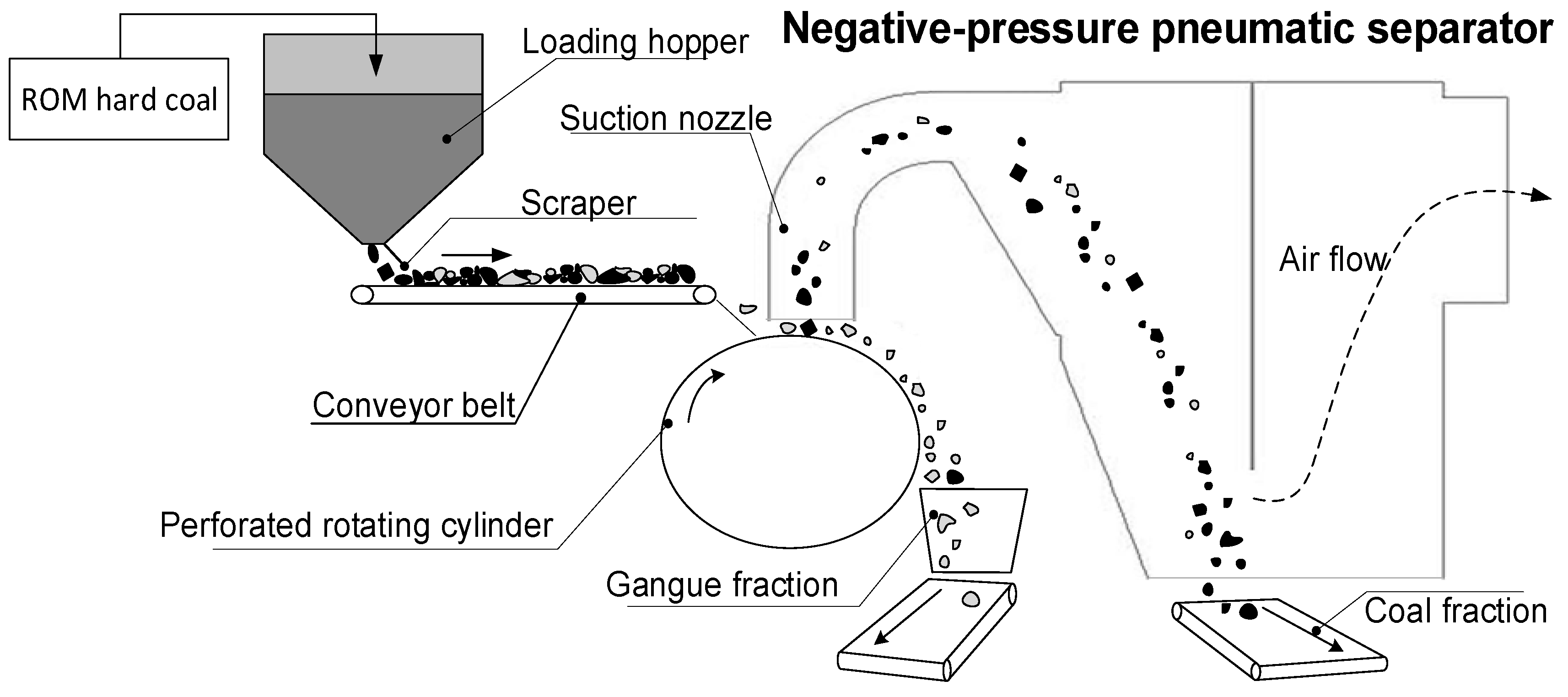
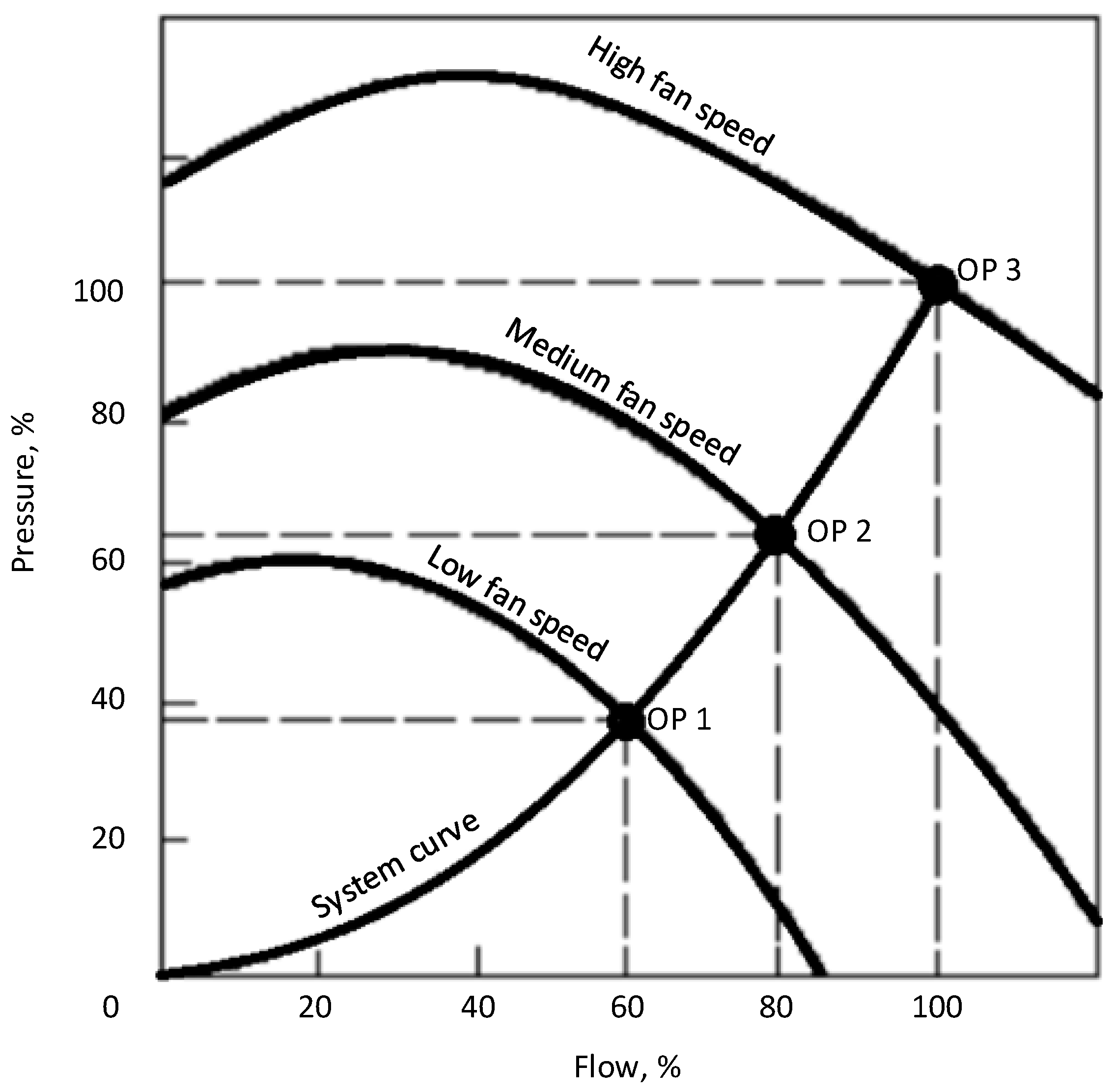
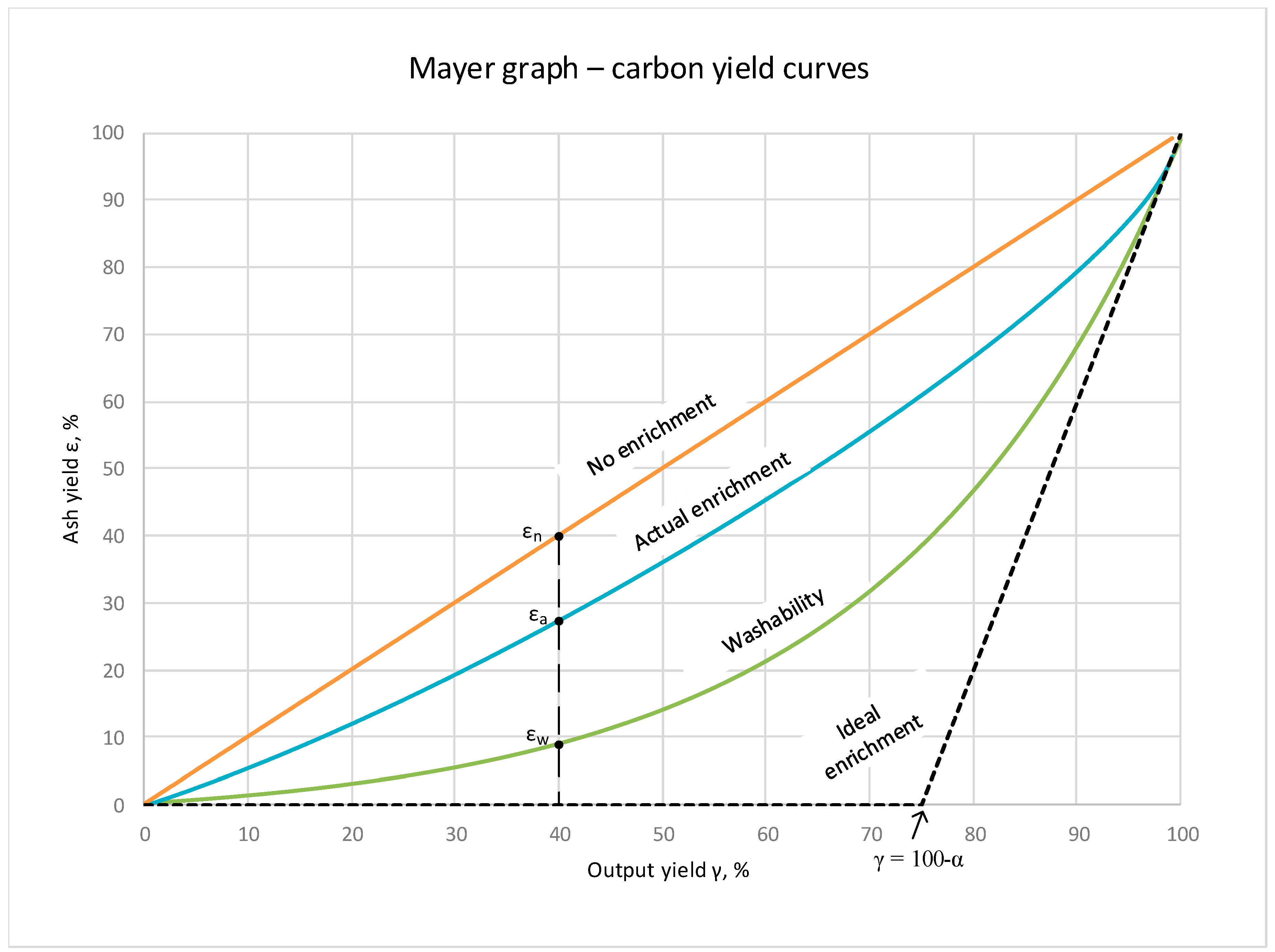

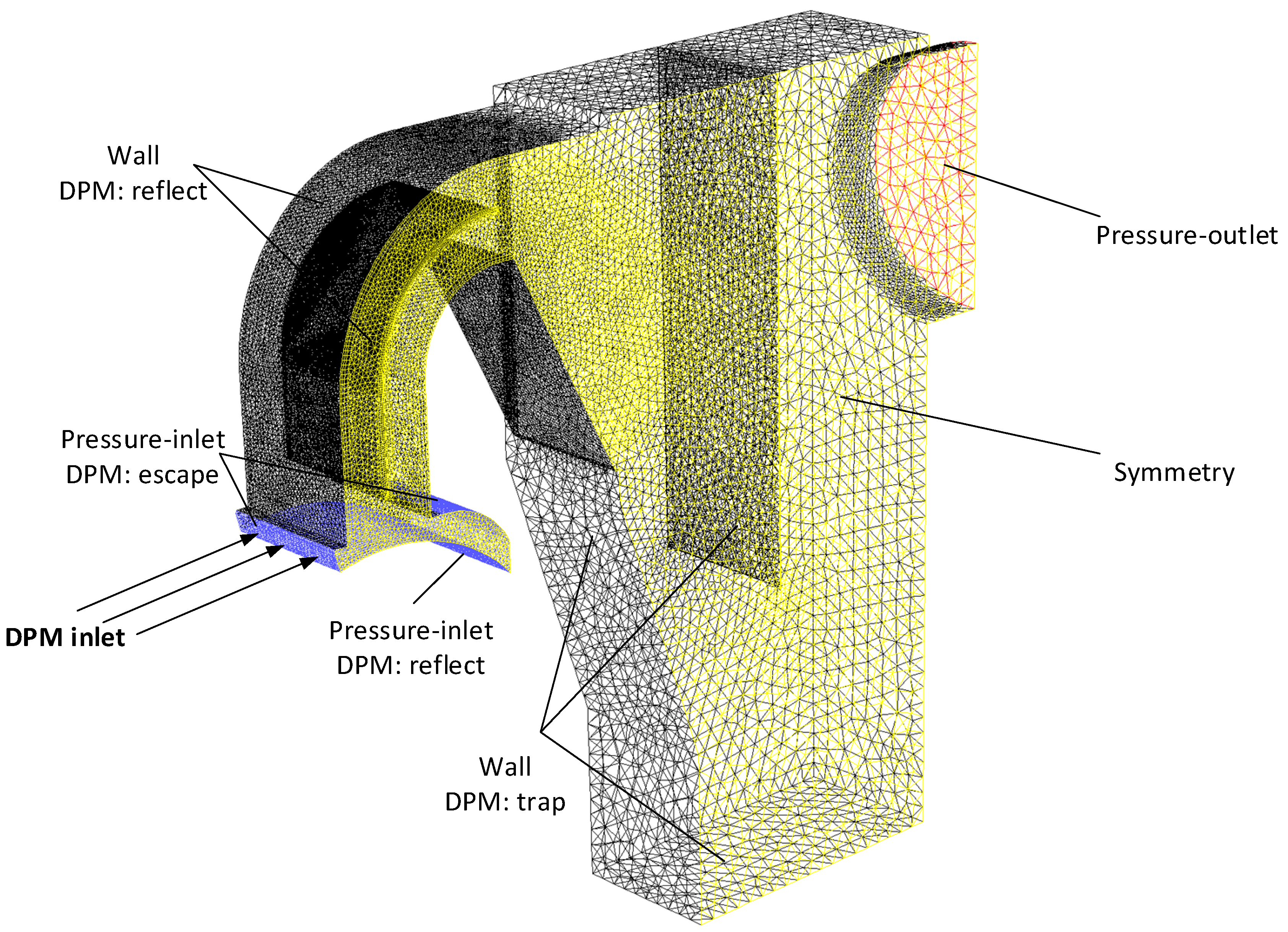

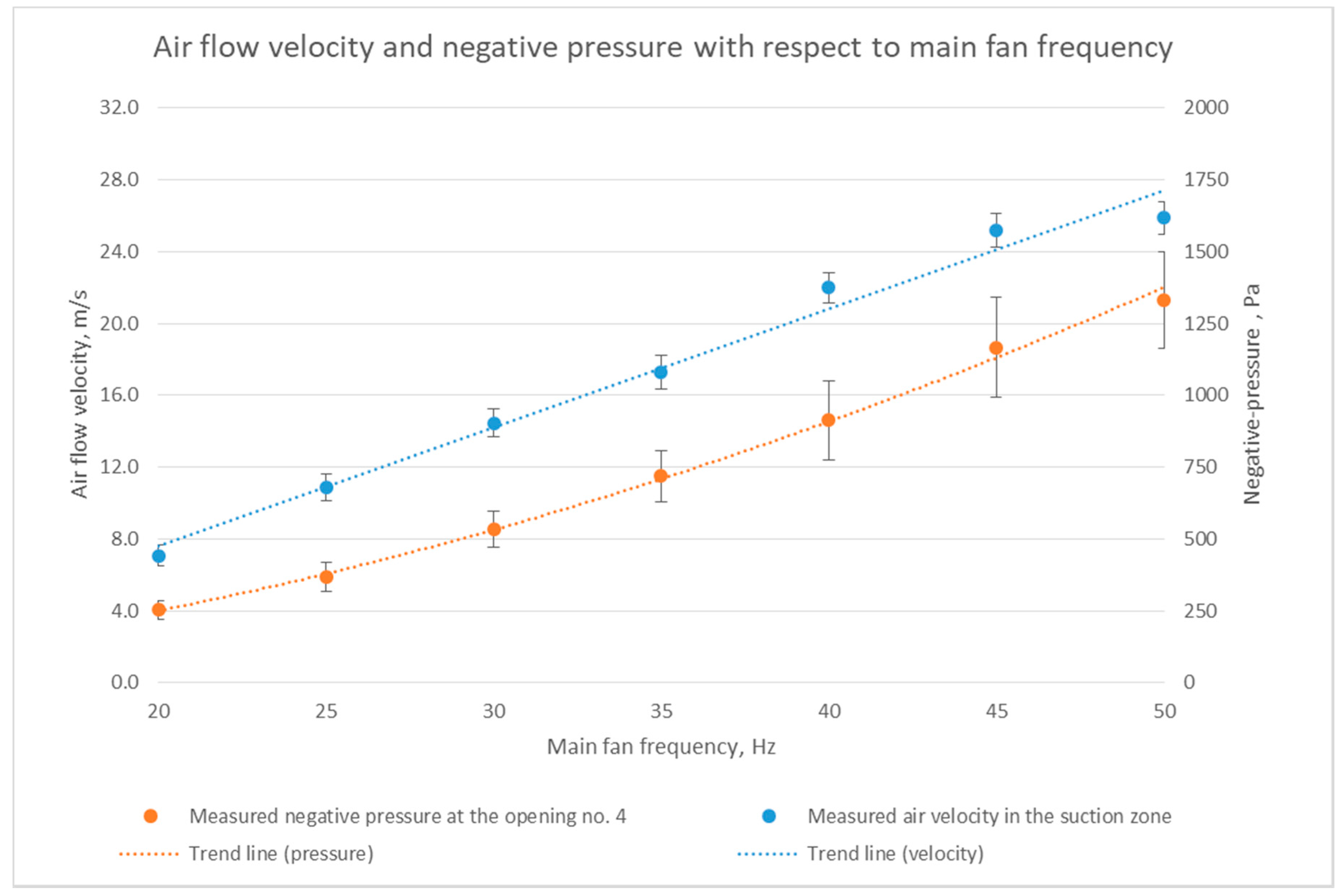
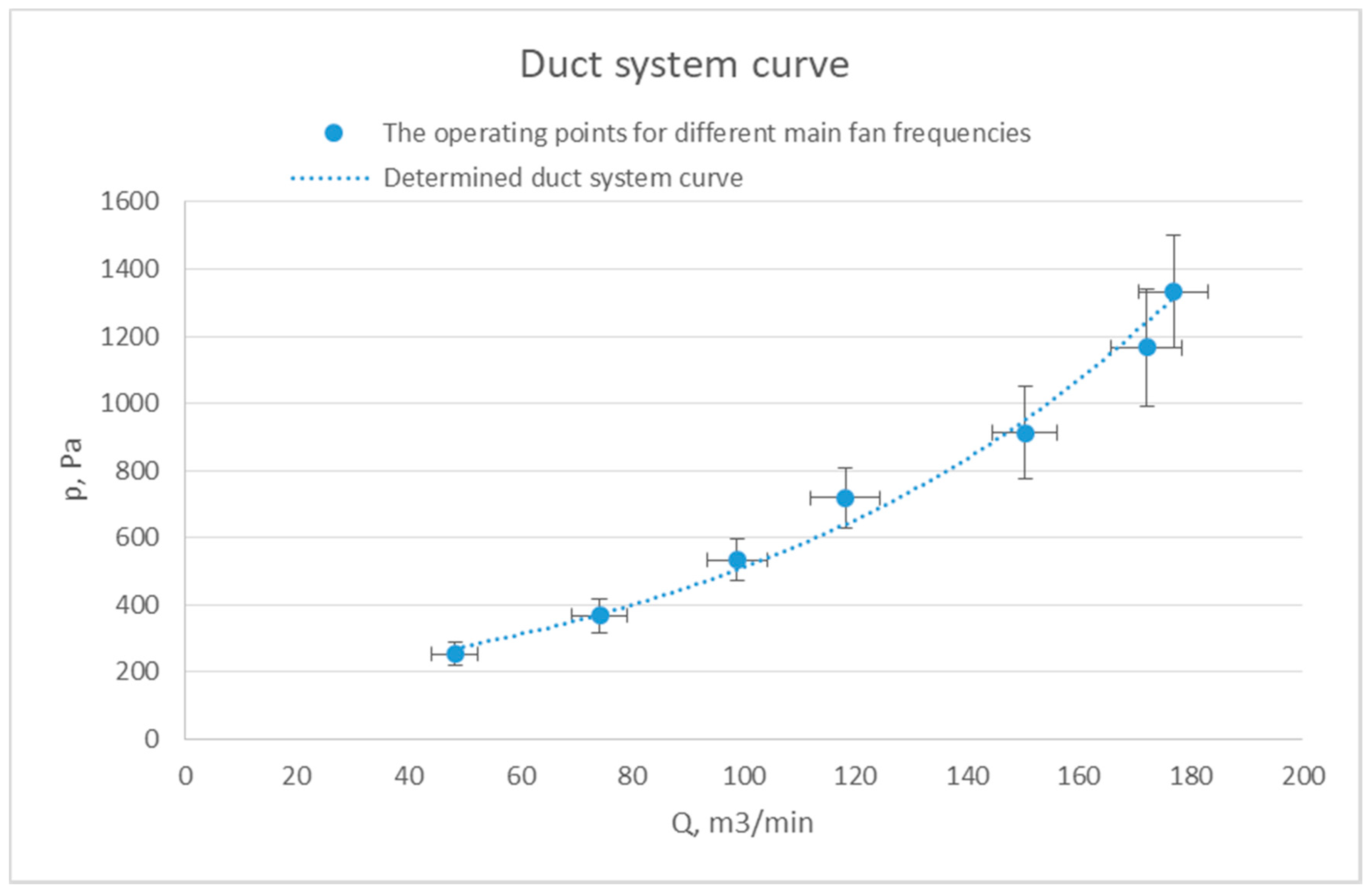
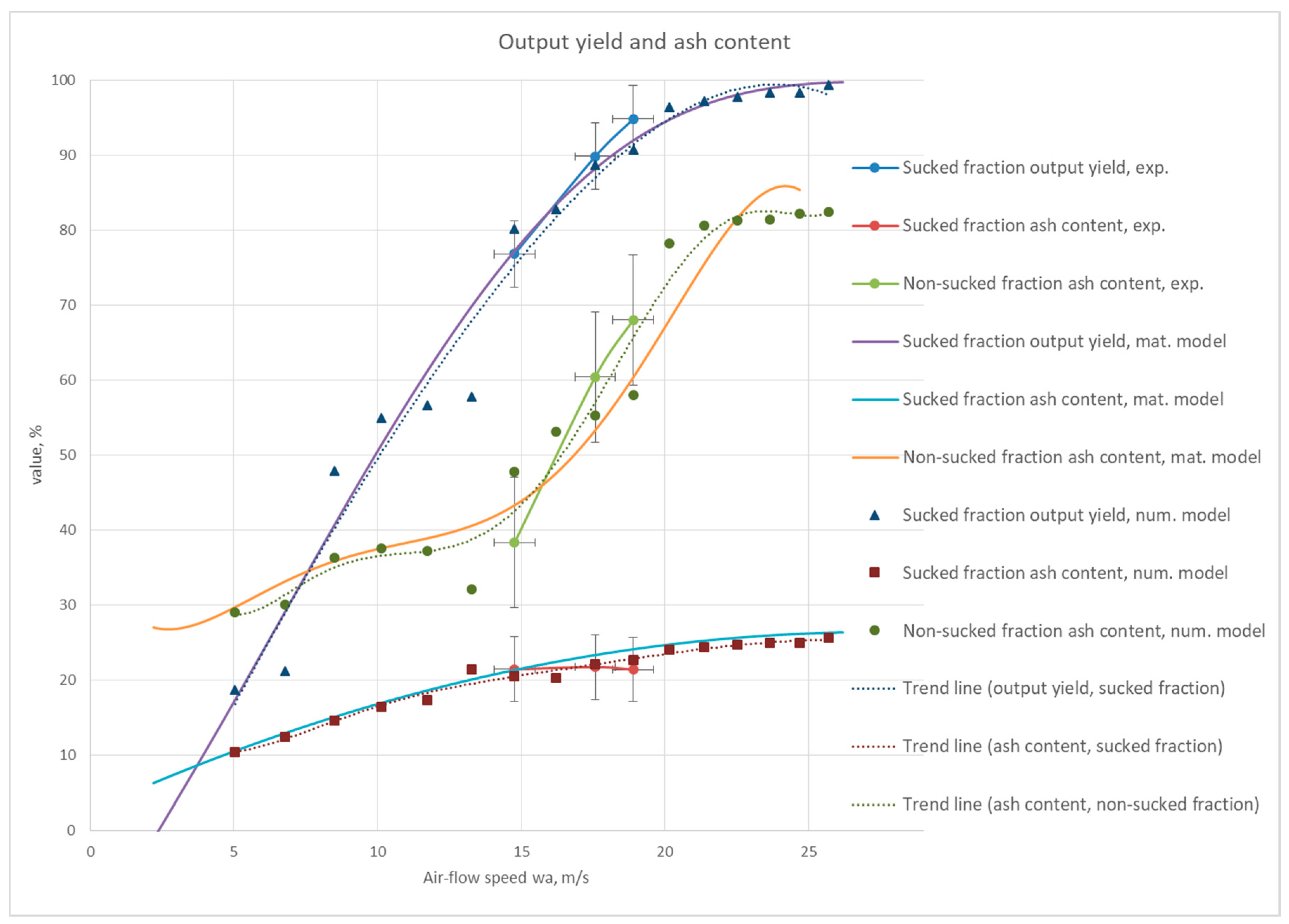

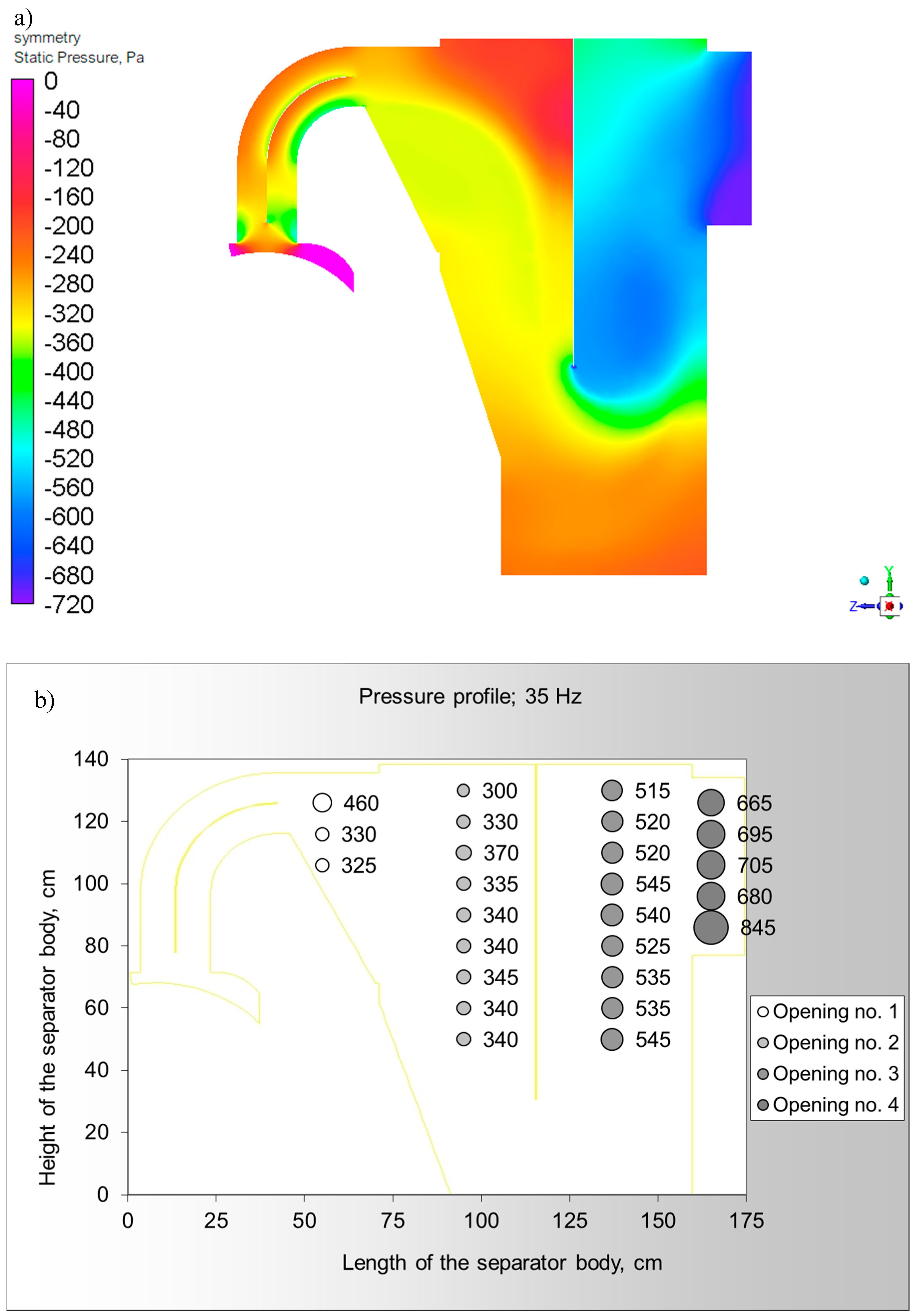

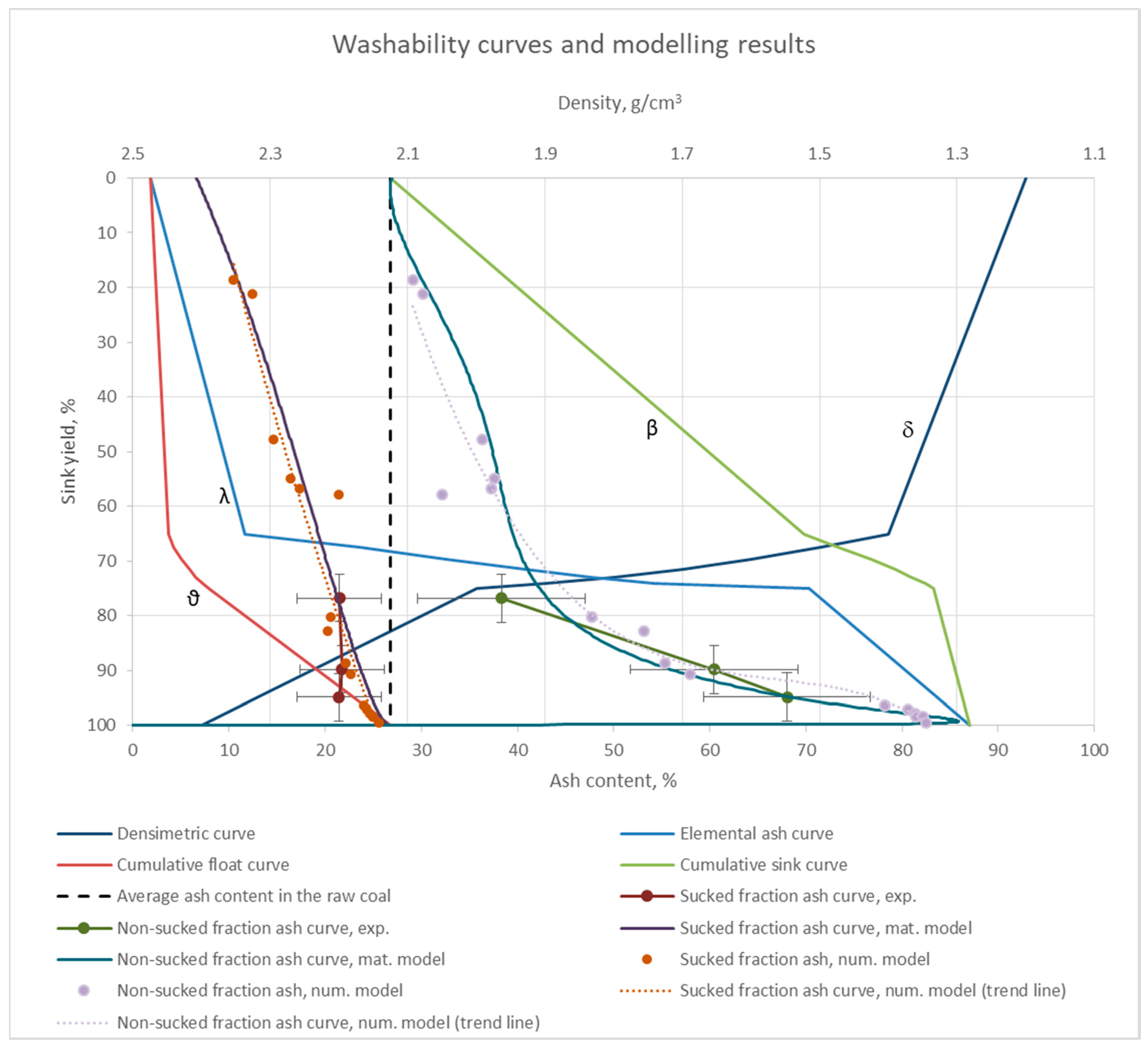
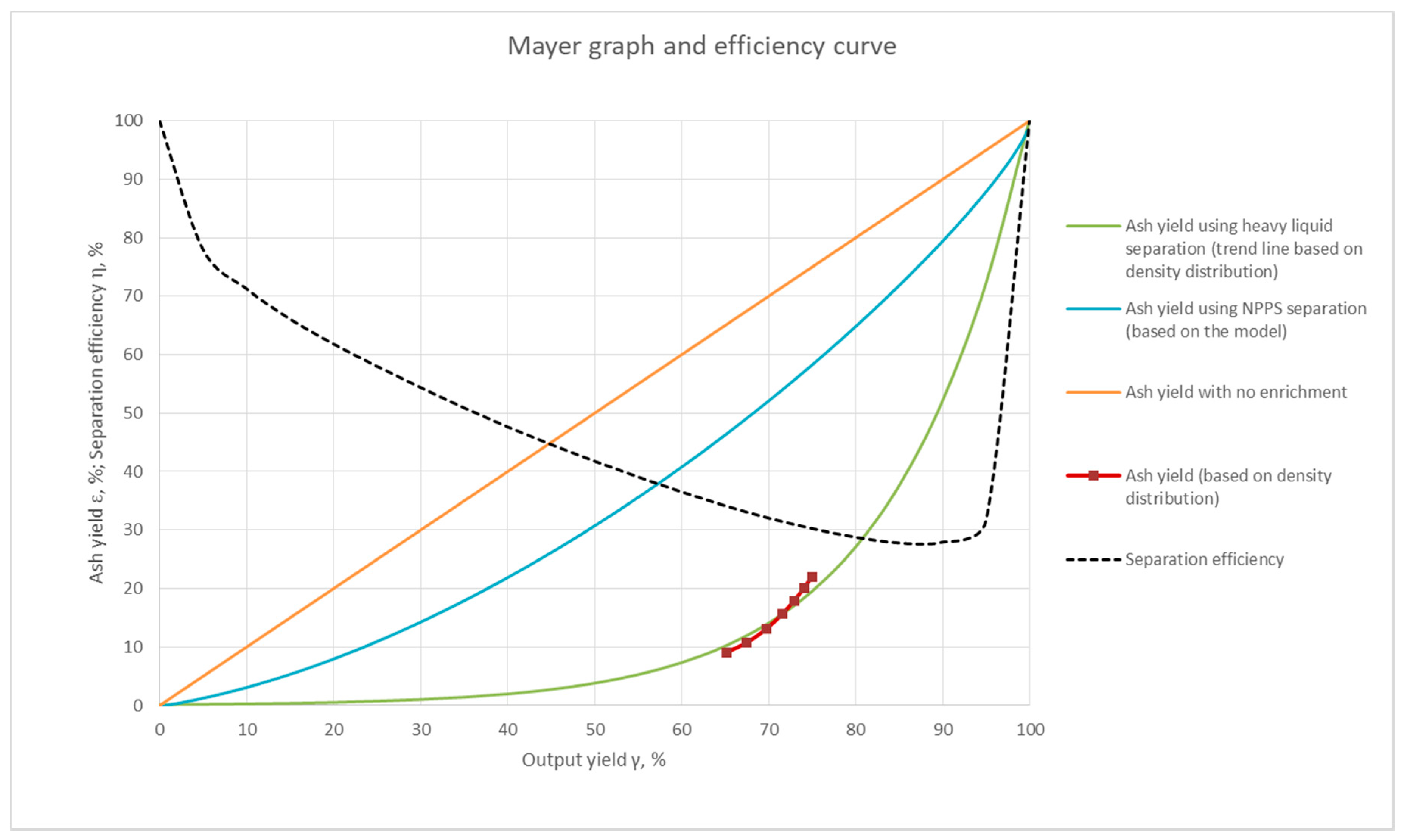
| Curve Coordinates | Equations |
|---|---|
| Product yield | |
| Waste yield | |
| Ash content in the product | |
| Ash content in the waste | |
| Average ash content in the raw coal | |
| Ash yield in the product |
| Grid Variant Number | 1 | 2 | 3 | 4 | 5 | 6 | 7 | |
|---|---|---|---|---|---|---|---|---|
| Mesh info | Nodes | 4621 | 37,506 | 56,159 | 175,948 | 483,270 | 1,990,955 | 11,930,172 |
| Elements | 18,091 | 152,444 | 224,117 | 691,329 | 1,951,394 | 8,227,042 | 50,104,709 | |
| Min./Avg. Orth. Quality | 9.1 × 10−4 / 0.731 | 0.077 / 0.842 | 0.11 / 0.844 | 0.108 / 0.861 | 0.0811 / 0.867 | 0.0789 / 0.871 | 0.0502 / 0.872 | |
| Max./Avg. Skewness | 0.99997 / 0.43 | 0.9998 / 0.27 | 0.98 / 0.26 | 0.89 / 0.24 | 0.92 / 0.23 | 0.92 / 0.23 | 0.95 / 0.22 | |
| Max./Avg. Aspect Ratio | 53,208 / 7.96 | 85.36 / 2.04 | 24.22 / 1.99 | 23.09 / 1.96 | 19.34 / 1.92 | 13.72 / 1.91 | 11.96 / 1.90 | |
| Average facet pressure | Point 1 (left), Pa | NO CONVERGENCE | −335.83 | −349.2 | −409.88 | −422.85 | −403.7 | COMPUTATION TOO EXPENSIVE (memory clogging) |
| Point 2 (middle), Pa | −373.38 | −390.84 | −426.35 | −437.3 | −417.28 | |||
| Point 3 (right), Pa | −639.43 | −651.41 | −655.35 | −652.48 | −652.04 | |||
| Average facet velocity | Point 1 (left), m/s | 23.5 | 24.03 | 26.08 | 26.71 | 25.85 | ||
| DPM results | output yield | 88.9% | 91.9% | 96.4% | 97.1% | 96.1% | ||
| ash of sucked fraction | 22.18% | 22.62% | 24.00% | 24.38% | 23.95% | |||
| ash of non-sucked fraction | 56.07% | 63.67% | 78.17% | 78.25% | 75.37% | |||
 | 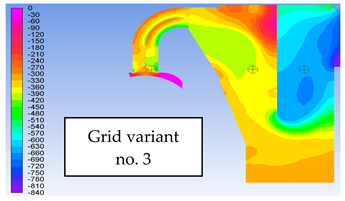 | |||||||
 | 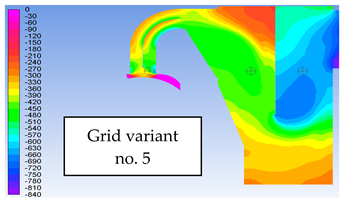 | |||||||
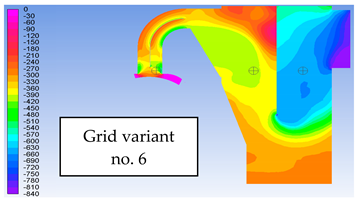 | 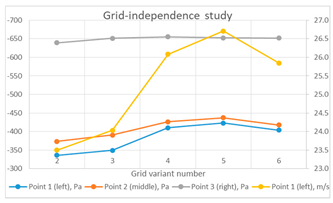 | |||||||
| Material Number | 1 | 2 | 4 | 5 |
|---|---|---|---|---|
| Injection type | Group | |||
| Number of streams | 40 | |||
| Diameter distribution | Rosin-Rammler | |||
| Min. diameter, mm | 1.0 | |||
| Max. diameter, mm | 20.0 | |||
| Average diameter, mm | 7.3 | 7.0 | 10.5 | 6.3 |
| Spread parameter | 1.07 | 0.61 | 1.34 | 0.85 |
| Main Fan Setting, Hz | Uncertainty Assessment of Pressure Measurement (Opening No. 4) | |||||||||
|---|---|---|---|---|---|---|---|---|---|---|
| Measured Negative Pressure, Pa | Uncertainty Calculation | |||||||||
| 1 | 2 | 3 | 4 | 5 | Mean Value | Stand. dev. ; tα = 0.317,n = 4 = 1.14 | Δdx | Δex | uc(p) | |
| 20 | 235 | 245 | 245 | 240 | 300 | 253 | 30 | 14 | 20 | 33 |
| 25 | 340 | 345 | 365 | 350 | 440 | 368 | 47 | 16 | 30 | 51 |
| 30 | 495 | 530 | 515 | 505 | 620 | 533 | 57 | 18 | 40 | 63 |
| 35 | 665 | 695 | 705 | 680 | 845 | 718 | 83 | 21 | 50 | 88 |
| 40 | 835 | 860 | 880 | 870 | 1120 | 913 | 133 | 24 | 60 | 138 |
| 45 | 1080 | 1100 | 1120 | 1100 | 1430 | 1166 | 169 | 27 | 70 | 175 |
| 50 | 1240 | 1280 | 1325 | 1240 | 1575 | 1332 | 160 | 30 | 80 | 167 |
© 2020 by the author. Licensee MDPI, Basel, Switzerland. This article is an open access article distributed under the terms and conditions of the Creative Commons Attribution (CC BY) license (http://creativecommons.org/licenses/by/4.0/).
Share and Cite
Stańczyk, K. Modelling of Hard Coal Beneficiation Process Utilising Negative Pressure Pneumatic Separator. Energies 2020, 13, 5174. https://doi.org/10.3390/en13195174
Stańczyk K. Modelling of Hard Coal Beneficiation Process Utilising Negative Pressure Pneumatic Separator. Energies. 2020; 13(19):5174. https://doi.org/10.3390/en13195174
Chicago/Turabian StyleStańczyk, Kamil. 2020. "Modelling of Hard Coal Beneficiation Process Utilising Negative Pressure Pneumatic Separator" Energies 13, no. 19: 5174. https://doi.org/10.3390/en13195174




